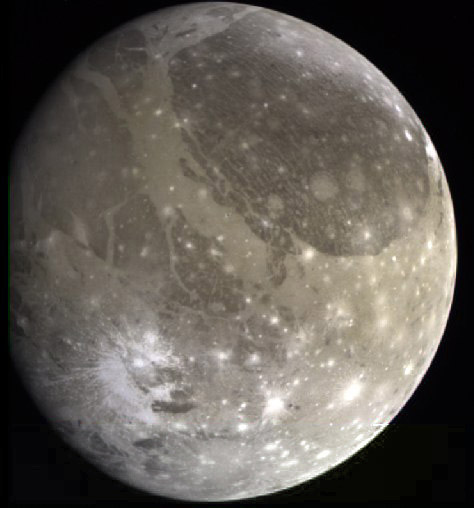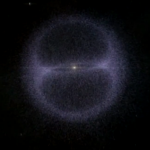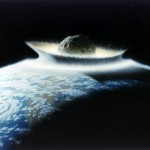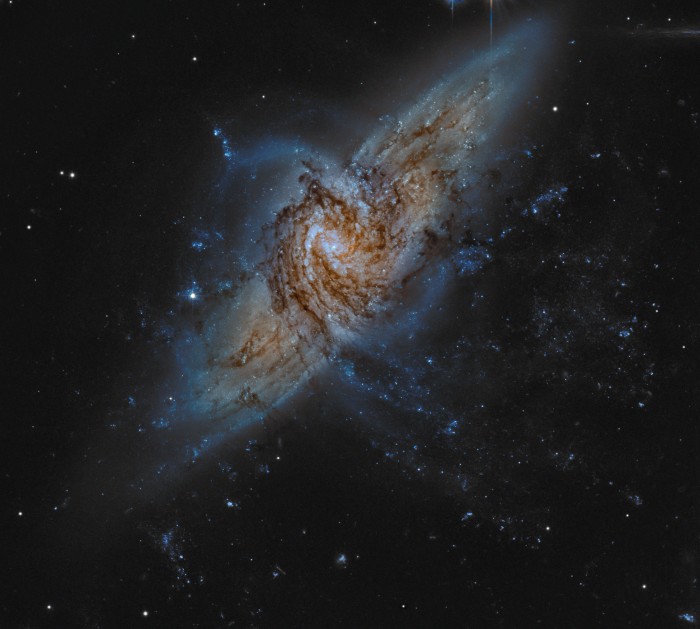Dark Matters
We’re nowhere near having a complete understanding of our universe. Here’s a nice video where physicists Daniel Whiteson and Jonathan Feng discuss why:
via PHD Comics
1970's NASA On Space Colonization
“They believe the space colony could be built before the year 2000.”
When Galaxies Overlap
From NASA APOD:NGC 3314 is actually two large spiral galaxies which just happen to almost exactly line up. The foreground spiral is viewed nearly face-on, its pinwheel shape defined by young bright star clusters. But against the glow of the background galaxy, dark swirling lanes of interstellar dust appear to dominate the face-on spiral’s structure. The dust lanes are surprisingly pervasive, and this remarkable pair of overlapping galaxies is one of a small number of systems in which absorption of light from beyond a galaxy’s own stars can be used to directly explore its distribution of dust. NGC 3314 is about 140 million light-years (background galaxy) and 117 million light-years (foreground galaxy) away in the multi-headed constellation Hydra. The background galaxy would span nearly 70,000 light-years at its estimated distance.
Give Me Space Exploration Or Give Me Death
Nevermind the usual, overly idealistic and romantic reasons for wanting to explore the universe. Here’s one that I imagine most people will agree with:
Whenever we discover a new celestial body up there in the sky, we nearly always see the same thing: The surface, if we can see it, shows the signs of torment caused by endless beatings by rogue planetary or stellar fragments:






Some worlds have been torn apart completely: Our own moon was once a part of this planet. When a rock the size of Mars struck the Earth, a fragment was propelled a quarter million miles away where it became known as the Moon.
We’re pretty sure that a rock from space effected the end of Cretaceous period.
Jupiter, which we like to think of as the protective big brother of our solar system, acts as a giant gravitational slingshot for objects not otherwise headed for Earth, spewing rocks left and right and in and out of our solar system at enormous speeds.
Between Mars and Jupiter is the great asteroid belt which contains more than 550,000 asteroids. The number of objects we detect there increases steadily—we’re nowhere near to tracking them all:
(Be sure to watch this in 1080p fullscreen.)
 Only the asteroid belt is seen in the video above—but on the outskirts of our solar system we are enveloped by the Oort cloud, a vast cloud of comets numbering a trillion or more, slowly circling our sun with varying trajectories. In this regard, the gravitational pull of the Sun and our neighboring planets is not our friend.
Only the asteroid belt is seen in the video above—but on the outskirts of our solar system we are enveloped by the Oort cloud, a vast cloud of comets numbering a trillion or more, slowly circling our sun with varying trajectories. In this regard, the gravitational pull of the Sun and our neighboring planets is not our friend.
There is only one surefire defense against this cosmic game of pong: Traveling elsewhere. Only when we inhabit other planets, other moons, giant space vessels, and, eventually, other star systems, will our species be resistant to the constant threat of cataclysmic impacts by space debris.
 We inhabit a small, fragile, white and blue water balloon which floats around a cosmic battlefield where the weapons used are stellar machine guns that use small planets as bullets—and we’re naïvely hopeful that our world won’t suddenly… pop.
We inhabit a small, fragile, white and blue water balloon which floats around a cosmic battlefield where the weapons used are stellar machine guns that use small planets as bullets—and we’re naïvely hopeful that our world won’t suddenly… pop.
If we do not decentralize our civilization—if we keep deferring the choice to go beyond the Earth to the next generation, and the next, in favor of feeding the immediate but ephemeral greed of the few—if we let this planet remain our species’ single point of failure, we will have only ourselves and our short-sightedness to blame for our eventual demise.
Since, in the long run, every planetary society will be endangered by impacts from space, every surviving civilization is obliged to become spacefaring—not because of exploratory or romantic zeal, but for the most practical reason imaginable: staying alive. And once you’re out there in space for centuries, for millennia, moving little worlds around and engineering planets, your species has been pried loose from its cradle. If they exist, many other civilizations will eventually venture far from home.
— Carl Sagan
We can discover and visit untold wonders in the depths of space, but it will be but a fortunate biproduct of our efforts to stay alive. We will pay the ultimate homage to Konstantin Tsiolkovsky and Robert Goddard, or we will die.
Beautiful Time-Lapse of the Australia Night Sky
No… words…
This time lapse video is the result of almost 1.5 years of work, 31 hours of taking images during six nights on Southern Ocean Coast in Australia.
Video by Alex Cherney
